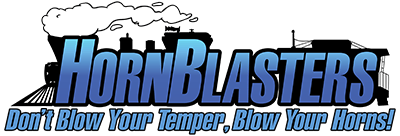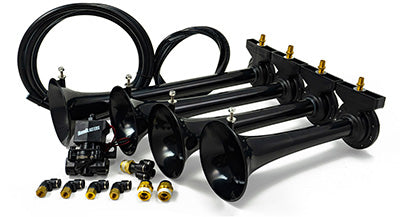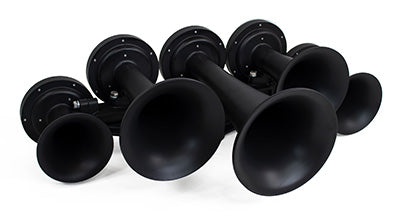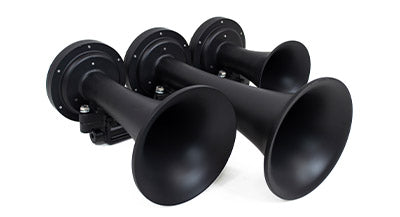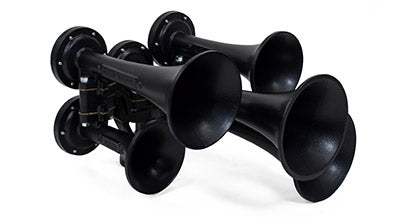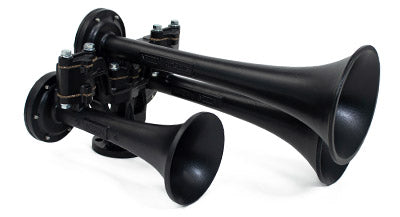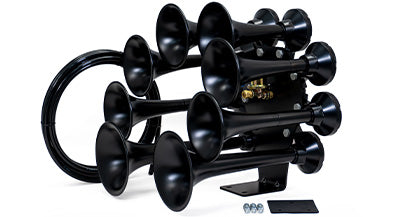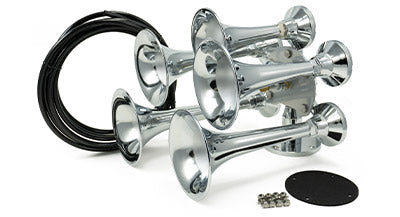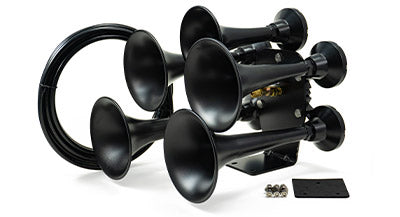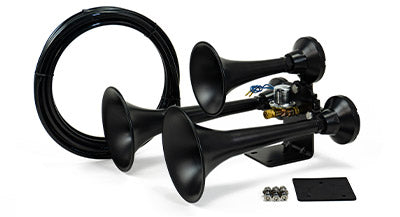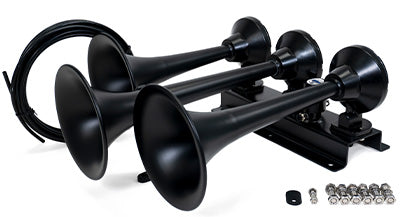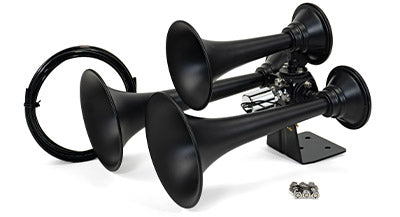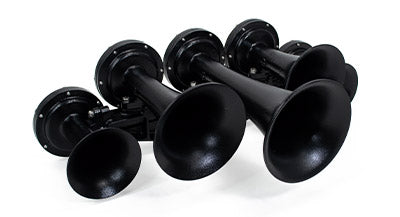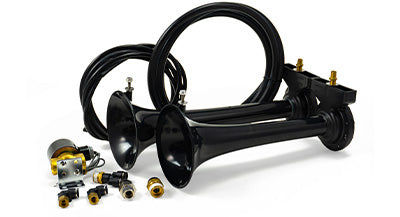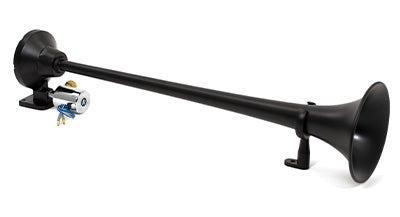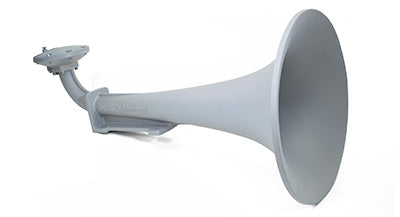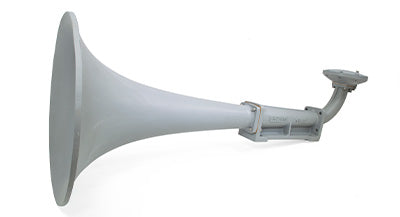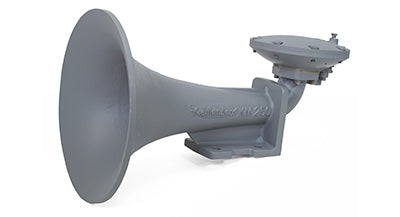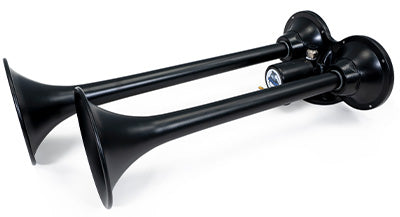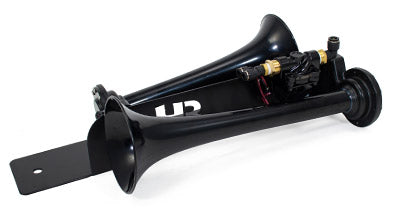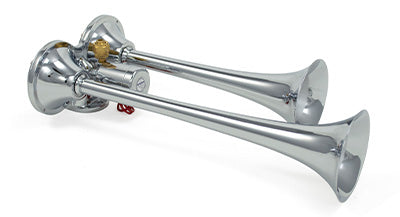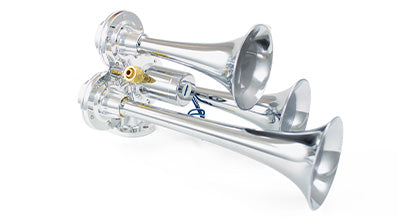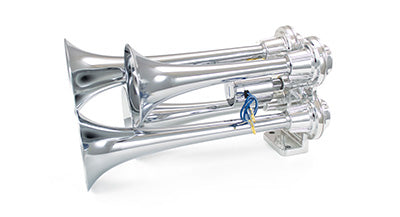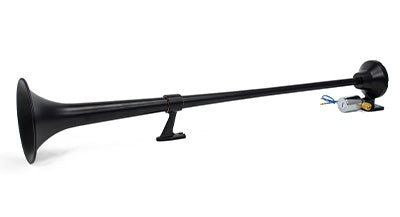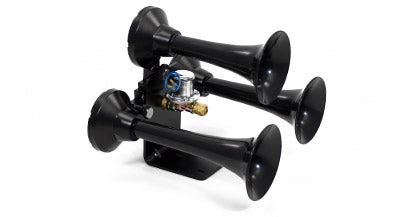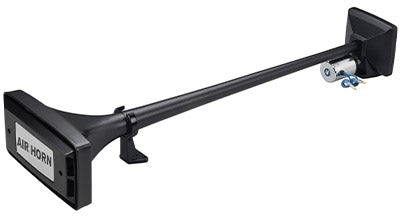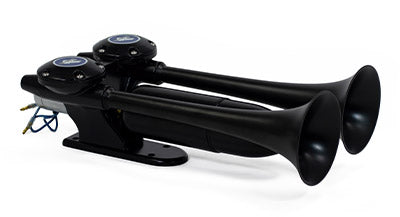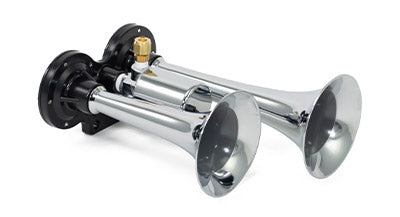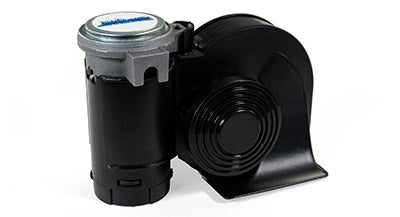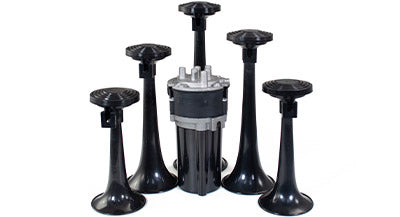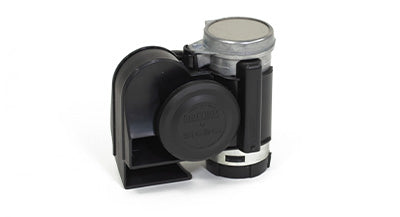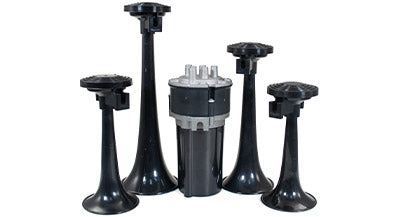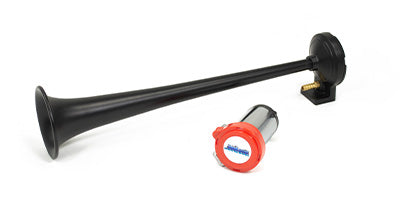Explore our diverse collection of horns through audio samples that let you experience the variety of tones we offer, from the unique air horn sound to traditional train horn melodies. These samples are curated to help you discern the distinct tones each horn produces, aiding in your selection process. While the true loudness and full sonic experience of our horns are best appreciated in person, these samples are a valuable tool for comparing the tonal qualities.
AUDIO SAMPLES
Find the tone that best suits your application!
TRAIN HORNS
AIR HORNS
ELECTRIC HORNS / MUSICAL HORNS
**All files are property of HornBlasters Inc. Copyright 2022. Contact media@hornblasters.com for usage inquiries.**
POPULAR QUESTIONS
WHAT IS THE LOUDEST TRAIN HORN AVAILABLE?
The loudest train horn available is the Nathan Airchime K5, reaching an impressive 149.4 decibels. It's matched closely by the Leslie RS-5T, with both horns well-regarded in the railroad industry for their exceptional power. Just a step behind these leaders are our own Shocker series horns. The Shocker XL, for example, comes in strong at 147.7 decibels, making it the second loudest horn on the market. These horns are a favorite among our customers, known for their powerful sound and dependable performance.
WHAT'S THE DIFFERENCE BETWEEN AN AIR HORN AND A TRAIN HORN?
The main difference between an air horn and a train horn is the variety and type of sounds they produce. Air horns can emit a range of sounds from sharp, singular tones to stuttering patterns and other unique auditory signals, designed for immediate attention in various environments. Train horns, on the other hand, are known for their distinctive, multi-tone sound that mimics the harmonized notes traditionally associated with trains, serving as a clear signal of a train’s approach and movement. While both types can achieve high decibel levels and are used in a broad array of vehicles—from golf carts to semis—as long as the vehicle supports a 12 or 24-volt system, it’s their specific sound characteristics and applications that set them apart.
WHAT IS THE MOST POPULAR TRAIN HORN?
Our most popular train horn is the Shocker XL, featured in all of our Conductor's Special train horn kits, including our Spare Tire Delete kits. Renowned for its powerful sound and durability, the Shocker XL offers a level of loudness that rivals authentic locomotive horns like the Nathan Airchime K5. Its versatility and dependable performance make it a top choice among enthusiasts aiming to make a significant impact. Additionally, the flexibility of individually mounted bells allows for various mounting configurations to suit any vehicle.
WHAT IS THE LOUDEST AIR HORN?
The Kahlenberg KM-85 is considered the loudest air horn available on the market. It is designed for marine and industrial applications where maximum sound penetration and clarity are essential. This air horn can produce sound levels that are capable of cutting through high background noise environments, making it exceptionally effective for alerting and signaling purposes.
WHAT SOUND DOES A TRAIN HORN MAKE?
A train horn produces a deep, resonant sound that can vary in pitch and duration but is typically characterized by its long, echoing blare. This sound is used as a warning signal to indicate a train's approach, movement, or presence at crossings to ensure safety for both train and pedestrian traffic. The sound can carry over long distances, alerting individuals well in advance of the train's arrival.
WHAT SOUND DOES AN AIR HORN MAKE?
An air horn produces a loud, piercing sound that is often described as a deep, blaring honk. This sound is created by the force of compressed air passing through a horn. The sound can vary slightly depending on the type and size of the horn, but it is universally recognized for its high volume and the ability to attract immediate attention.
HOW MANY MILES AWAY CAN YOU HEAR A TRAIN HORN?
You can typically hear a train horn from 3 to 5 miles away under normal conditions. This range can extend further in rural areas with less ambient noise or during certain weather conditions that carry sound more effectively.
WHAT IS THAT AIR HORN SOUND IN HIP HOP?
The air horn sound in hip hop is a sample or effect that has been widely used in the genre to accentuate drops, highlight transitions, or emphasize moments in the music. This sound has become iconic in hip hop and DJ culture, symbolizing celebration, excitement, and attention-grabbing. Its usage can be traced back to dancehall and reggae influences, where it was originally used in live performances to energize the crowd.
WHAT DO 2 SHORT BLASTS FROM A TRAIN HORN MEAN?
Two short blasts from a train horn are a signal indicating that the train is about to start moving or is continuing its movement after a stop. This signal is part of a standardized code used by trains to communicate with rail workers and other trains, ensuring safety and coordination on the tracks.
WHAT DOES 3 HORNS ON A TRAIN MEAN?
Three blasts from a train horn are a signal indicating that the train is backing up or moving in reverse. This warning is crucial for the safety of workers and pedestrians in the vicinity, alerting them to the train's movement direction so they can take appropriate caution.
WHAT IS THE SOUND OF A TRAIN CALLED?
The sound of a train is commonly referred to as a "train horn" sound. The specific action of making the sound is often called "blowing the horn" or "sounding the horn."
CAN YOU HEAR A TRAIN HORN FROM 2 MILES AWAY?
The sound of a train is commonly referred to as a "train horn" sound. The specific action of making the sound is often called "blowing the horn" or "sounding the horn."
WHY DO TRAINS HONK SO LOUD AT NIGHT?
Trains honk loudly at night to ensure safety as visibility decreases. The loud horn serves as a warning to prevent accidents at crossings and around tracks, especially when pedestrians and drivers may be less alert.
WHAT IS A LOUD TRAIN HORN?
A loud train horn is a type of horn used on locomotives that produces a very high decibel sound, capable of being heard over great distances. These horns are designed to alert pedestrians and vehicular traffic to the presence of a train, particularly at crossings. One of the loudest train horns available is the Nathan Airchime K5, which can reach a sound level of 149.4 decibels. This horn is known for its powerful and penetrating sound that ensures effective communication of a train’s approach or presence.
DO TRAINS HONK OR HORN?
The correct terminology when referring to the sound made by a train is that trains "honk" their horns. The device itself is called a horn, and the action of using it is typically referred to as "honking."
DO TRAINS HONK OR TOOT?
Trains typically "honk" rather than "toot." The term "honk" is used to describe the loud and forceful sound made by train horns, which is intended to alert nearby individuals of the train's presence and movements.
WHY DO TRAINS HONK TWO LONG, ONE SHORT, ONE LONG?
This horn signal pattern—two long, one short, and one long—is used by trains to warn that they are approaching a public railroad crossing. This signal is mandated by law in the United States under specific circumstances to ensure that road users are aware of the approaching train, enhancing safety at crossings.

